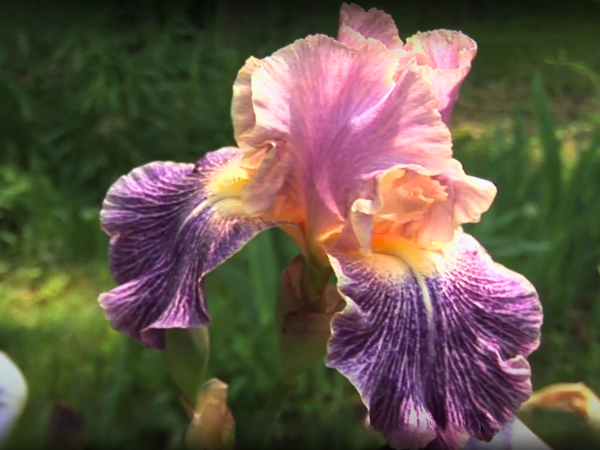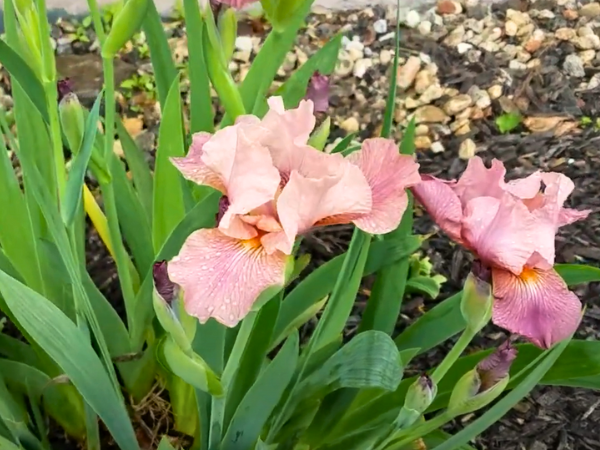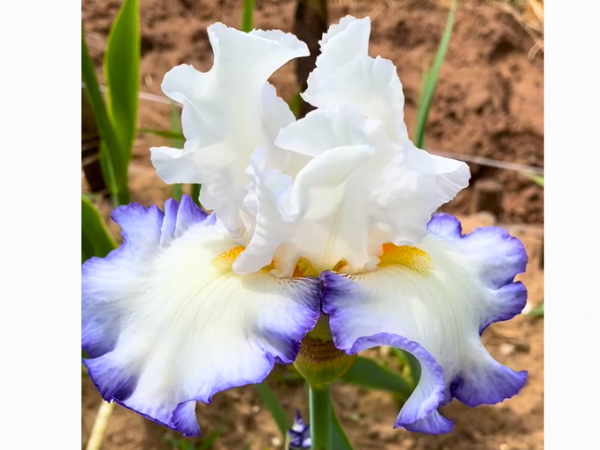In this guide, we will explore the various types of pink iris flowers, how to care for them, and what they mean. Pink irises come in different shapes and shades, each with its own charm.
We will also discuss the meanings behind these lovely blooms, adding depth to your appreciation of them.
What Are Pink Iris Flowers ?
These blooms belong to the Iris family, known for their unique shapes and vibrant colors. Pink Irises are less common than their blue or purple counterparts, making them a special find.
- Variety of Shades: Pink Irises come in different shades, from soft pastel pinks to vibrant magenta.
- Frilled Petals: The petals are often ruffled, giving them a delicate appearance.
- Height and Growth: They typically grow between 24 to 36 inches tall, ideal for borders and garden beds.
- Seasonal Blooms: Pink Irises bloom in late spring to early summer, adding color when many plants are still waking up.
Here is a simple table showing some popular Pink Iris varieties:
| Variety | Color Shade | Height |
|---|---|---|
| Pink Attraction | Soft Pink | 30 inches |
| Rosy Vision | Vibrant Magenta | 36 inches |
| April Dawn | Pale Pink | 28 inches |
These flowers not only beautify gardens but also create a sense of tranquility. Their soft pink hues can brighten any space.
Pink Iris Flowers 5PCS with Stems 23.6

Symbolism And Cultural Significance Pink Iris
Pink Iris flowers often symbolize hope, femininity, and admiration in gardens and floral art. Their gentle appearance reflects grace and beauty, making them popular in various traditions.
- Hope: The pink color represents optimism and new beginnings.
- Feminine Strength: Pink Irises celebrate femininity, often associated with love and compassion.
- Admiration: Giving Pink Irises can express heartfelt admiration for someone special.
They are often used in bouquets for weddings, symbolizing love and devotion. In some cultures, Pink Irises are associated with spring, representing renewal and life.
Popular Varieties Of Pink Iris
Popular varieties of pink iris showcase beautiful blooms and offer different care needs. Let’s explore some of the most loved pink iris types.
Beverly Sills Iris
The Beverly Sills Iris is an award-winning soft pink iris with ruffled edges. This variety blooms in late spring and can reach heights of 36 inches.
Key features include:
- Height: 36 inches
- Bloom time: Late spring
- Color: Soft pink with ruffled edges
- Fragrance: Lightly fragrant
Caring for Beverly Sills is straightforward:
- Plant in well-drained soil.
- Water regularly, especially during dry spells.
- Fertilize in early spring for best blooms.
This iris thrives in full sun to partial shade. It attracts butterflies, adding charm to your garden.

Pink Attraction Iris
The Pink Attraction Iris is a fragrant reblooming type with deep rose tones. This iris can bloom multiple times throughout the growing season, making it a favorite among gardeners. It typically grows to about 30 inches tall.
Notable characteristics include:
- Height: 30 inches
- Bloom time: Early spring and reblooming in late summer
- Color: Deep rose with a strong fragrance
To care for Pink Attraction Iris:
- Choose a sunny spot with well-draining soil.
- Water deeply but infrequently.
- Deadhead spent blooms to encourage reblooming.
This variety stands out in flower beds and borders. Its sweet scent adds an inviting touch to gardens.

Queen’s Circle Iris
The Queen’s Circle Iris features pink tones with lavender accents. This variety is known for its unique color combination and elegant shape. It grows to about 28 inches tall and blooms in mid-spring.
Here are some key details:
- Height: 28 inches
- Bloom time: Mid-spring
- Color: Pink with lavender accents
For optimal growth, follow these care tips:
- Plant in full sun for best color.
- Ensure soil is well-drained.
- Fertilize once in spring.
Queen’s Circle Iris adds a soft touch to any garden setting. Its unique colors make it a standout choice for flower enthusiasts.

The Unique Palette Of Iris Colors
The unique palette of iris colors offers endless options for gardeners and flower lovers.
Visual Gallery: Exploring These Unique Iris Colors
The beauty of irises is truly mesmerizing. They come in many colors, from deep blues to soft pinks. Each color holds its own significance. Here are some popular iris colors to explore:
- Blue Iris: Represents faith and hope.
- Pink Iris: Symbolizes love and compassion.
- Purple Iris: Stands for wisdom and royalty.
- Teal Iris: Combines the calm of blue and the warmth of green.
These combinations create a vibrant display in any garden. The soft hues of pink and the rich tones of purple create a striking contrast. They attract butterflies and other pollinators.
How To Grow And Care For Pink Irises
To grow and care for pink irises, understanding their specific needs is essential. This guide will help you cultivate these lovely flowers successfully.
Soil And Sun Requirements
Pink irises thrive in conditions that mimic their natural habitat. They prefer well-drained soil, which is crucial for their health. Here are some key points to consider:
- Soil should be rich in organic matter.
- pH level should be between 6.0 and 7.0.
- Avoid heavy clay or overly wet soils.
Sunlight is equally important for pink irises. They need at least 6+ hours of sun daily to flourish. Choose a location that receives full sun to ensure vibrant blooms.
Make sure to prepare your garden bed well. Incorporate compost or well-rotted manure to improve soil quality.
Watering And Fertilizing Tips
Watering pink irises requires a balanced approach. They prefer moderate watering. Here are some tips for effective watering:
- Water deeply but infrequently.
- Allow the soil to dry out between waterings.
- Avoid waterlogging to prevent root rot.
Fertilizing is also important for growth. Apply a low-nitrogen fertilizer in spring. This helps promote strong blooms without excessive foliage growth. Follow these steps for fertilizing:
- Choose a balanced fertilizer with low nitrogen.
- Apply it when new growth appears.
- Follow package instructions for dosage.
Observe your plants regularly. Adjust watering based on rainfall and temperature. Healthy pink irises will reward you with vibrant blooms throughout the season.
Common Pests And Problems
Like all plants, pink irises can face challenges. Being aware of common pests and problems can help you act quickly. One of the main pests is the iris borer. This pest can damage the leaves and bulbs. Here are some prevention tips:
- Inspect plants regularly for signs of borers.
- Remove any damaged foliage immediately.
- Consider using insecticidal soap if needed.
Another issue is fungal diseases, like fungal leaf spot. This can cause unsightly spots on leaves. To prevent this:
- Water at the base of the plant to keep leaves dry.
- Ensure good air circulation around plants.
- Avoid overcrowding when planting.
Taking these precautions will help keep your pink irises healthy and blooming beautifully.

Planting And Growing Pink Iris Bulbs
Planting and growing pink iris bulbs is easy with the right knowledge. This guide will help you understand the best practices for planting these lovely flowers.
Best Time And Location To Plant
The best time to plant is in late summer or early fall. This timing allows the bulbs to establish roots before winter. Choose a sunny location that receives at least six hours of sunlight each day.
Consider these points for a successful planting:
- Plant in a spot with full sun.
- Avoid areas with standing water.
- Check soil drainage; it should be loose and well-drained.
Here is a simple table to remember the ideal conditions:
| Condition | Recommendation |
|---|---|
| Time of Year | Late summer to early fall |
| Sunlight | Full sun (6+ hours) |
| Soil Type | Well-drained, sandy or loamy |
Choosing the right location and timing ensures healthy growth for your pink irises.
Proper Spacing And Depth For Bulbs
Spacing and depth are key to successful growth. Plant pink iris bulbs with enough space to allow for their spread. Space the bulbs 12–24 inches apart.
When planting, place the rhizomes just below the soil surface. This depth allows them to anchor well while avoiding rot. Follow these steps for proper planting:
- Dig a hole about 4-6 inches deep.
- Place the bulb in the hole, ensuring the top is just below the soil.
- Fill the hole with soil and press down gently.
- Water lightly to settle the soil.
Proper spacing and depth create a healthy environment for pink irises to bloom beautifully.
Care After Planting
After planting, caring for your pink iris bulbs is essential. Water deeply once, then allow the soil to dry between waterings. This method prevents overwatering, which can lead to bulb rot.
Here are some care tips to follow:
- Fertilize with a balanced fertilizer in early spring.
- Remove weeds around the planting area to reduce competition.
- Monitor for pests and diseases; treat them quickly if noticed.
Following these care tips will help your pink irises thrive and bring beauty to your garden.






